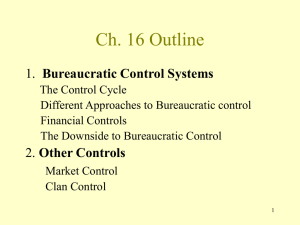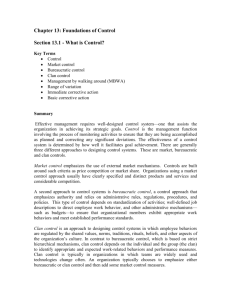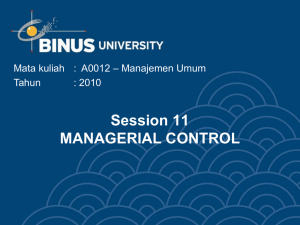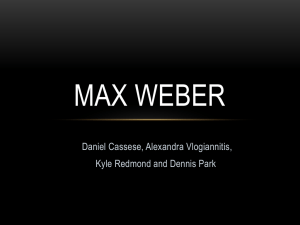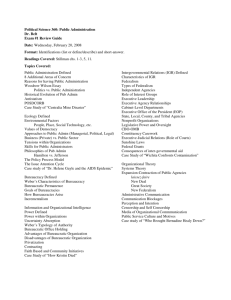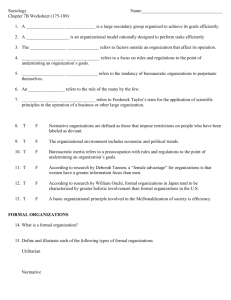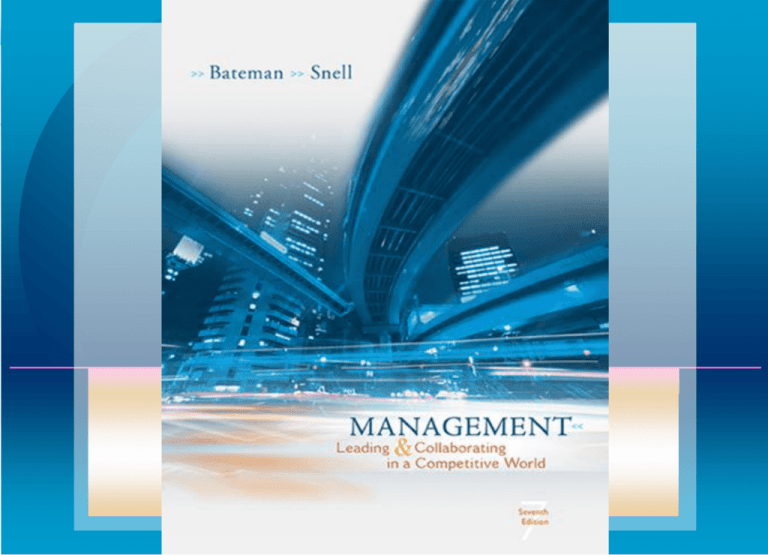
16-1
Chapter
16
Managerial Control
McGraw-Hill/Irwin
Management, 7/e
Copyright © 2007 The McGraw-Hill Companies, Inc. All rights reserved.
16-3
Learning Objectives
After Studying Chapter 16, You will know:
Why companies develop control systems for
employees
How to design a basic bureaucratic control system
The purposes for using budgets as a control
device
How to interpret financial ratios and other
financial controls
The procedures for implementing effective control
systems
The different ways in which market control
mechanisms are used by organizations
How clan control can be approached in an
empowered organization
16-4
Control
Control is essential for the attainment of any
management objective
Control is any process that directs the
activities of individuals toward the
achievement of organizational goals
16-5
Characteristics of Control
Managers can apply three broad strategies for
achieving organizational control
Bureaucratic control is the use of rules,
regulations, and formal authority to guide
performance
Market Control involves the use of pricing
mechanisms to regulate activities in organizations
as though they were economic transactions
Clan control I based on the idea that employees
may share the values, expectations, and goals of
the organization and act in accordance with them
16-6
Control Problems
16-7
Bureaucratic Control Systems: The
Control Cycle
A typical bureaucratic control system has
four major steps
Setting performance standards
Measuring performance
Comparing performance against the standard
and determining deviations
Taking corrective action
16-8
The Control Cycle
16-9
Approaches to Bureaucratic Control
There are three approaches to bureaucratic
control
Feed forward Control takes place before
operations begin and includes policies,
procedures, and rules designed to ensure that
planned activities are carried out properly
Concurrent control takes place while plans are
being carried out and includes directing,
monitoring, and fine-tuning activities
Feedback control focuses on the use of
information about results to correct deviations
from the acceptable standard after they arise
16-10
Management Audits
Management audits are an evaluation of the
effectiveness and efficiency of various
systems within an organization
Management audits may be
External – this occurs when one organization
evaluates another organization
Internal – these are a periodic assessment of a
company’s own planning, organizing, leading,
and controlling processes
16-11
Budgetary Controls
Budgetary control is the process of finding
out what’s being done and comparing the
results with the corresponding budget data to
verify accomplishments or remedy
differences
This is one of the most widely recognized and
commonly used methods of managerial
control
It is commonly called budgeting
16-12
Budgetary Control
Budgetary control begins with an estimate of
sales and expected income
One of the primary considerations is the
length of the budget period
16-13
Types of Budgets
Sales budget - Usually data for the sales budget are
prepared by month, sales area, and product
Production budget - The production budget commonly
is expressed in physical units
Cost budget - The cost budget is used for areas of the
organization that incur expenses but no revenue, such
as human resources and other support departments
Cash budget - The cash budget shows the anticipated
receipts and expenditures, the amount of working
capital available, the extent to which outside financing
may be required, and the periods and amounts of cash
available
Capital budget - The capital budget is used for the cost
of fixed assets like plant and equipment
Master budget - The master budget includes all the
major activities of the business
16-14
Financial Controls
Two financial statements that help control
overall organizational performance are:
Balance sheet shows the financial picture of a
company at a given time
Profit and loss statement is an itemized
financial statement of the income and
expenses of a company’s operations
Financial ratios are also an effective approach
for checking on the overall performance of
the enterprise
16-15
The Downside of Bureaucratic Control
A control system cannot be effective without consideration
of how people will react to it
Three types of responses
Rigid bureaucratic behavior occurs when control systems
prompt employees to stay out of trouble by following the rules
rather than doing the right thing
Tactical behavior leads to ineffective behavior because
employees try to beat the system
Resistance to control occurs because
Control systems uncover mistakes, threaten job security
and status, and decrease autonomy
Control systems can change expertise and power
structures
Control systems can change the social structure of an
organization
Control systems may be seen as an invasion of privacy
16-16
Designing Effective Control Systems
Effective control systems maximize potential
benefits and minimize dysfunctional behaviors
Five characteristics of effective control systems
They are based on valid performance standards
They communicate adequate information to
employees
They are acceptable to employees
They use multiple approaches
They recognized the relationship between
empowerment and control
16-17
Market Control
Market controls involve the use of economic forces –
and the pricing mechanisms that accompany them – to
regulate performance
System is based on the principle that as output from
an individual, department, or business unit creates
value to other people, a price can be negotiated for its
exchange
Two effects of this occur
Price becomes an indicator of the value of the product
or service
Price competition has the effect of controlling
productivity and performance
16-18
Market Controls
16-19
Market Controls
At the corporate level market controls are
used to regulate independent business units
At the business unit level market controls are
used to regulate exchanges among
departments and functions
Transfer price is the price charged by one unit
for a product or service provided to another
unit within the organization
16-20
Market Controls
Market controls are
used at the
individual level to
determine wage
levels for the skills
that employees
possess
16-21
Clan Control: The Role of Empowerment
and Culture
Managers are discovering that control
systems based solely on bureaucratic and
market mechanisms are insufficient for
directing today’s workforce because
Employee’s jobs have changed
The nature of management has changed
The employment relationship has changed
Because of this empowerment has become a
necessary aspect of a manager’s repertoire of
control
16-22
Clan Control: The Role of Empowerment
and Culture
Clan control involves creating relationships
built on mutual respect and encouraging each
individual to take responsibility for his or her
actions
Employees work within a guiding framework
of values, and they are expected to use good
judgment
The emphasis in an empowered organization
is on satisfying customers, not on pleasing
the boss
Clan control takes a long time to develop and
an even longer time to change
16-23
Clan Control: The Role of Empowerment
and Culture
16-24
Looking Ahead
After Studying Chapter 17, You will know
The processes involved in the development of new
technologies
How technologies proceed through a life cycle
How to manage technology for competitive
advantage
How to assess technology needs
The key factors to consider when making decisions
about technological innovation
The roles different people play in managing
technology
How to develop an innovative organization
The key characteristics of successful development
projects
16-25
Performance Standards
A standard is the level of expected
performance for a given goals
Performance standards can be set with
respect to
Quantity
Quality
Time used
Cost
Return
16-26
Measuring Performance
Performance date is commonly obtained from
three sources
Written reports, which include computer
printouts
Oral reports
Personal observation
Information must be provided on a timely
basis
Return
16-27
Comparing Performance
For some activities relatively small deviations
from the standard may be acceptable, in while
in others a slight deviation would be serious
The principle of exception states that control
is enhanced by concentrating on the
exceptions, or significant deviations, from
the standard
Return
16-28
Taking Corrective Action
This step ensures that operations are
adjusted where necessary to achieve the
initially planned results
In computer-controlled production there are
two basic types of control
Specialist control states that the operators of
computer-numerical-control machines must
notify engineering specialists for corrective
action to be taken
Operator control states that multi-skilled
operators can rectify their own problems as
they occur
Return
16-29
Balance Sheet
Te statement itemizes three
elements of the organization
Assets are the values of the
various items the corporation
owns
Liabilities are the amounts a
corporation owes to various
creditors
Stockholders’ equity is the
amount accruing to the
corporation’s owners
Return
16-30
Profit and Loss Statement
Comparative
statements allow
managers to view
how income and
expenses have
changed over the
last period
Return
16-31
Financial Ratios
Liquidity ratios indicate a company’s ability to pay
short-term debts
Current ratio – indicates the extent to which current
assets can decline and still be adequate to pay current
liabilities
Leverage ratios show the relative amount of funds in
business supplied by creditors or shareholders
Debt to equity ratio indicates the company’s ability to
meet its long-term financial obligations
Profitability ratios indicate management’s ability to
generate a financial return on sales and/or
investments
Return on Investment (ROI) is a ratio of profit to capital
used or a rate of return from capital
Return

